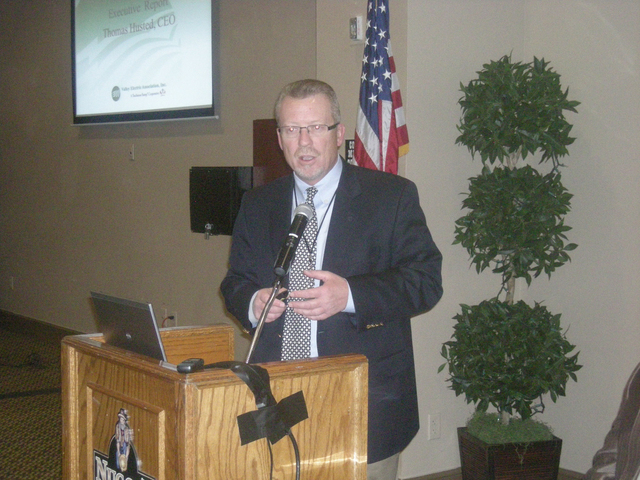
Valley Electric Association officials promised to return capital credits this December and keep rates steady until at least 2018, during the District 1 board meeting at the Pahrump Nugget Hotel and Casino Tuesday night.
It was one of six annual district meetings the cooperative schedules each year.
Rick Eckert, VEA executive chief operating officer, said the cooperative had annual revenues of $70.17 million in 2013, an increase of $18.5 million or 35.5 percent in one year. Expenses increased by $11.4 million, up 19 percent. This was an increase of $7.3 million from the negative margins in 2012, he said. Margins are what the co-op refers to as profits. Net margins in 2013 were more than $137,000.
Revenues had been fairly flat since 2009, with a significant jump in 2013, Eckert said. VEA finished 2013 with $320 million of total utility plant assets, a $58.4 million increase in one year, long-term debt increased by $104 million to $256 million. Eckert described 2013 as “a year of progression.”
VEA Chief Executive Officer Tom Husted outlined the major changes in 2013: Transitioning to the California Independent System of Operators (CAISO) on Jan. 3; energizing the new 55-mile northwest transmission line project; the award of $100 million in new contracts, including the Nevada National Security Site and Creech Air Force Base; the successful defense of the contracts before the Public Utilities Commission; Gov. Brian Sandoval’s veto of a bill that would place VEA under Public Utilities Commission oversight; an increase in the workforce by 20 percent; the announcement of the campus expansion plan; the doubling of assets; a reduction in power supply costs by 25 percent and a forecast of $13.2 million in net revenues the next five years.
“We’ve expanded our business capabilities by bringing on these new contracts. Remember, these new contracts brought on new revenues and we’ve expanded our infrastructure to be able to allow us to not only better serve you but to expand the business. These expansions have allowed us to increase revenues $20 million and guess what? None of it came from you,” Husted told the 70 members in attendance.
Power supply costs make up 55 to 60 percent of expenses. Husted said they decreased that cost by 25 percent at the end of 2013, an additional $7.3 million added to the $20 million increase in revenues for the bottom line. But he said VEA officials in October were looking at a possible rate increase for 2014.
“VEA thrives in spite of the greatest recession in the history of the United States,” Husted said to applause. “We have a business approach and that is, we are going to create our future, as opposed to waiting for the future to come up and tell us what is going to happen to our co-op. We said no. We know what is happening in this country, we’re going to create our future. We’re going to look for opportunities and we have.”
“We’ve expanded the business opportunities, we’ve expanded infrastructure, we found a way to increase revenues to bring revenues in to pay for this additional infrastructure and now we’re forecasted over the next five years to have positive net margins of almost $14 million. Now we’re going to pay back patronage capital. We’re going to be in a position to have long-term rate stability, our forecast right now is at eight years,” Husted said. But he added, “we believe even though the forecast says 2018 that’s plenty of time to find another solution.”
Husted said otherwise sales have been flat. Eckert said residential sales, which are 52 percent of total sales, only increased 1 percent to 271.1 million kilowatt hours in 2013. Commercial members, who buy 26 percent of the power, purchased 135.1 million kilowatt hours, only .16 of a percent more. Sales to irrigation customers rose 5.8 percent, but the 32.5 million kilowatt hours forms only 6 percent of total sales. But contract sales were 78.1 million kilowatt hours, a 449.7 percent increase, he said.
Husted anticipated questions he asked himself. Long-term debt has doubled, but he said outside revenues were developed to pay for it. Without referring to the company by name, objections by NV Energy to the contracts awarded VEA for the federal facilities led to statements VEA was no longer acting like a co-op, Husted said. He answered by reciting the definition of a co-op, “a member-owned co-op that provides goods and services on behalf of its members.”
Husted defended VEA’s statewide advertising campaign as well as the need to expand its offices.
He also acknowledged the lower prices charged to the NNSS than contract sales, as part of their system of charging different for various consumer categories. “They all cover their expenses and they all develop profit.”